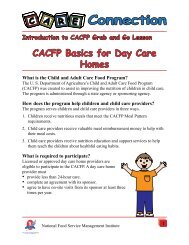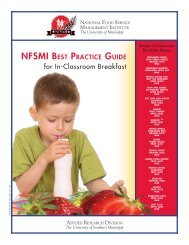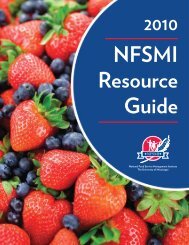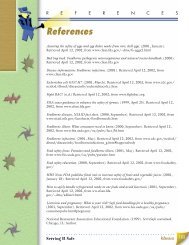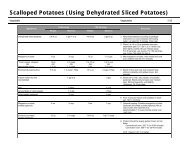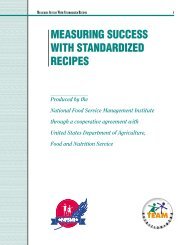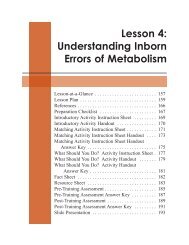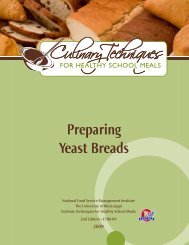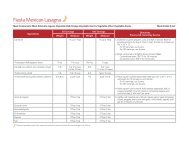financial management information system - National Food Service ...
financial management information system - National Food Service ...
financial management information system - National Food Service ...
Create successful ePaper yourself
Turn your PDF publications into a flip-book with our unique Google optimized e-Paper software.
S ECTION 5B UDGETING• Combination incremental and zero-based - A combination that uses zero-based for some items and incremental forother items is usually considered the best approach for school foodservice budgeting. Some items in the budget shouldbe based on need without preconceived estimates based on the previous year. For other items, the existing budget needonly be adjusted to accommodate price changes. The method used will depend on the item being budgeted andcircumstances. For example, if the district anticipates a substantial increase in enrollment due to an influx of peopleinto the community, then both revenue and expense funds that are directly related to student population should bebudgeted from zero. However, if there are no expected changes in student participation, revenue sources, or programcosts, then incremental budgeting may suffice.The Budgeting ProcessThe basic steps of the budget process may vary from school district to district. In some school districts, the foodserviceadministrator may have sole responsibility for preparing the budget for the foodservice department. In other districts,though the foodservice administrator may be involved, the compilation of the total budget is often the responsibility of abusiness official. Regardless of the process, it is important for the school foodservice administrator to be aware of thebudget- planning process. If the budget is going to be an effective <strong>financial</strong> <strong>management</strong> tool, then it is important for theschool foodservice administrator to work with school business officials to ensure the development of an accurate budget, toreview the proposed budget for the foodservice department before it is finalized, and to establish the budget as a standardagainst which operations are evaluated. The following steps are necessary during the budget-planning process:• Establish long-term goals. What should occur in the program over the next five or ten years?• Develop a budget plan. What sources for revenue generation will be considered in development of the budget? What arethe categories of expected expenditures? What reports should be included in the budget analysis? Which budgetingmethod will be used for projecting revenues and expenditures?• Project revenue based on all applicable factors. How much revenue will be available from local, state, and federal sources forstudent meals? How will an increase in meal price or reimbursement rates affect the revenue? Are adult and other foodsales likely to increase, decrease, or remain the same? What are other revenue sources, such as interest on bank deposits,food rebates, sale of surplus equipment, and other miscellaneous items?• Estimate expenditures carefully. The heart of the budget preparation is estimating expenditures for the upcoming year.While it is difficult to make the estimation exact, every effort should be made to make it accurate. A worksheet with adetailed breakdown of each expense category, similar to the schedules in Section 3, may prove helpful when planningthe budget.• Budget for the entire year. In school foodservice it may be preferable to break down the year by months and then add themonths to determine a total annual budget. For instance, the amount budgeted for revenues and expenditures for Julywill reflect a very different program status than the amounts budgeted for August or September. Regardless of themethod, the final budget should reflect an annual <strong>financial</strong> plan.Analyzing the BudgetThe budget should be analyzed on a regular basis for control purposes. Budget reports should be prepared and analyzed noless often than monthly. For example, comparing actual costs with the budgeted amount for a given category may revealtrends or deviation from the standards.N ATIONAL F OOD S ERVICE M ANAGEMENT I NSTITUTE 82



